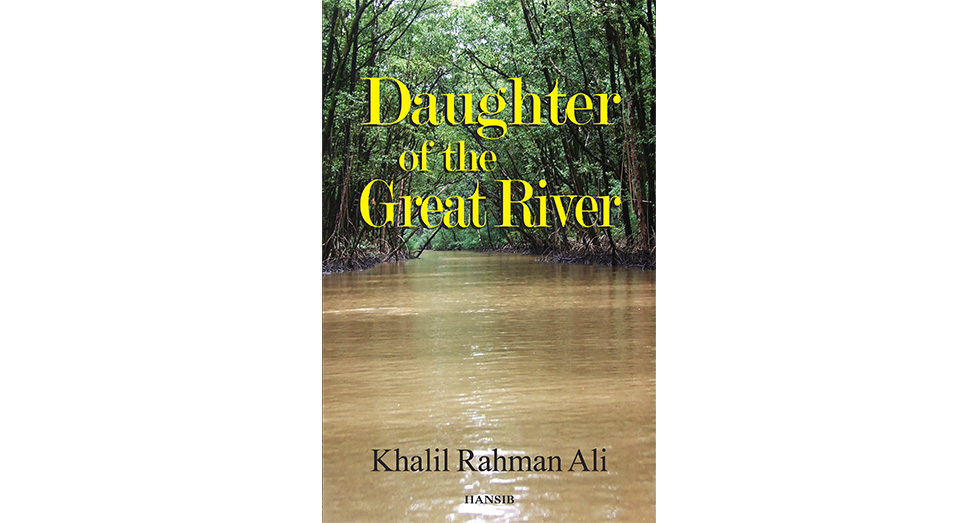A short story from Daughter of the Great River by Khalil Rahman Ali
THE world stood still as the midnight hour of a new millennium approached. Preparations had been completed by billions of people in every corner of the planet as the first second of the new year 2000 was awaited with bated breath. Elaborate and costly plans were in place to manage the uncertainty of computer and other systems moving from the end of the year 1999 to the beginning of 2000.
Deep in the rainforest that made up most of the land of Kayana, in the north of South America, all the members of a small settlement of the Kayanese tribe of Indigenous Peoples also sat silently and patiently around the outside of the benab, or big house. They were awaiting the arrival of a special baby whom they believed to be the chosen one to save them, the rainforest, Kayana, and the world. This was far more important to the residents than the anxieties of a changeover of computer systems from 1999 to 2000.
The settlement, situated deep in the lush green rainforest of Kayana, known as The Land of Many Waters, was not easily accessible to others, except for the members of the two-hundred-strong, resilient, and resourceful tribe. The site was carefully chosen by their Chief, or Cacique, over five hundred years prior—just off the tributary of the longest river, known as the Great River of Kayana. He, along with a handful of men, women, and children, had escaped from further northwards of the country due to brutal persecution by invading Europeans.

The life-giving tributary was about two hundred yards wide at its mouth and cut through the vegetation on both banks, narrowing to only a few yards wide further and higher into the rainforest. This allowed ideal protection for the settlement. It also offered a variety of fish, shrimps, and crabs, which had always been a main source of food for the families.
The dark brown water flowed steadily through, with small ripples lapping against the grey, muddied banks. The first inhabitants who found and set up the settlement had cut a narrow path through the vegetation into the large opening where their huts were built in a great circle around one central structure called the benab.
The benab was circular in design and built upon strong timber legs which supported the roof made of leaves and vines. It served as a communal resting and meeting place. A carefully cleared and maintained bare-earth area in front of the benab was specially set out for celebratory dances, games, and day-to-day gatherings.
The population of the settlement had managed to grow and survive over the centuries through the successive Chiefs’ astute guidance and avoidance of contact with strangers, including members of other Indigenous tribes. Skills for hunting and physical self-defence were taught and handed down to the young over time. The older women taught young girls essential weaving skills, cooking, and general housekeeping, as well as the strenuous lifting and carrying of baskets of cassava, their main ground provision.
The people’s watchful and protective approach had provided them with security over the centuries, until a more recent contact with strangers caused the outbreak of a severe incidence of pneumonia which almost decimated the entire population. However, over the last thirty years, the community had managed to rebuild itself and had tried to adapt to its new situation.
The entire community initially sat quietly on their haunches outside the benab, as the oldest female member—who would become the baby’s great-grandmother—offered traditional prayers throughout the labour. No men were allowed in or near the birthplace, and they joined the gathering outside in a separate group.
The expectant mother was only eighteen years old and had endured a very difficult first pregnancy. However, upon advice from her grandmother, she was not taken from the settlement to receive more modern maternity care and support from the midwives and doctors stationed at the community hospital in a small town about thirty miles up the Great River. The old lady was particularly keen for the special baby to be born within the benab, in the presence of the tribe.
The sombre chanting continued in a mesmeric rhythm for several hours into the night, only pausing at the sound of agonising cries caused by the acute pain of labour. A local band of howler monkeys responded noisily upon hearing the cries of the mother-to-be, as if in empathy with her. Their calls carried higher and deeper into the surrounding forest. Their black coats made them difficult to spot high in the trees, until they leapt from branch to branch, aided by their strong arms, legs, and long tails.
Finally, at midnight, the young mother gave a sustained cry as the baby was born. A few moments of utter silence were then broken by the faint wail of the newborn. Then, as the weary onlookers began to stir, they were alarmed to hear the screams of the women attending the birth.
The great-grandmother, who was just less than five feet tall, slowly stood up and cradled the baby, which was wrapped in a white cotton towel. Tears trickled down her wrinkled cheeks from her tired, reddened eyes as she tried to forge a smile. She stepped forward to the open entrance of the benab and stood at the top of the short stairway. The entire audience looked up with great joy at the new child of the millennium. They spontaneously raised their arms in prayer to welcome the promised chosen one and new Chief.
The old lady raised the bundle above her head as the baby began to cry.
She said, “Hail to our future Chief! Rise up to welcome our Onida, the Daughter of the Great River! Long live our chosen one!”
Everyone shouted, “Long live our Onida! Long live our Chief Koko!”
The howler monkeys screamed excitedly as their message rang out through the forest.
About the Author
Khalil Rahman Ali is a successful author who was born in Guyana, South America, and has lived, studied, and worked in London, England, since 1970.
His first three historical fiction novels—Sugar’s Sweet Allure (2013), The Domino Masters of Demerara (2015), and In Pursuit of Betterment (2017)—are based on the experiences of the Indians who were indentured to work on sugar plantations between 1835 and 1920 in several countries around the world, including Guyana, Trinidad, Jamaica, Mauritius, Fiji, Réunion, Suriname, and South Africa, and their descendants who are part of the Indian diaspora.
Khalil has a keen interest in the environment, climate change, and the sustainability of the planet. He believes that the Indigenous Peoples of the world are best suited to help sustain and save the planet. This latest novel offers an insight into the problems and threats facing Indigenous Peoples living in the rainforests.
He is a keen traveller, loves sports, and is an accomplished Indian singer and musician. Khalil hopes that Daughter of the Great River will help to inspire individuals, communities, and governments around the world to work harder to save the planet.





.jpg)








